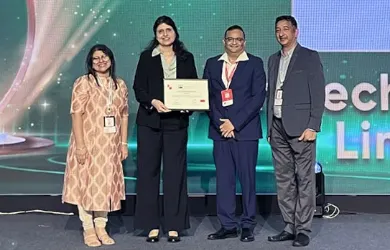- Our Story
- Our Impact
-
Our Projects
Commercial
- Careers
Smart Cities: Digital Transformation of Our Cities for The Better
By Lodha
July 15, 2020When one thinks of smart cities, you tend to imagine them as perceived in popular culture - cities with tall structure, robots, flying cars, humanoids and more. But in reality, smart cities are a focused approach to ensure good governance, sustainability, equal distribution of resources, provision of basic amenities, infrastructure, transportation, healthcare and more. This is achieved through use of technology and systematic planning. World over, there are several cities that are transforming themselves and providing better lives to their citizens with implantation of smart solutions. The Government of India too had rolled out the Smart Cities Mission in 2015, a program to retrofit 100 cities to being technologically smart and sustainable.
The Plan
The initiative involves the transformation of the existing locations of a city to better the livability conditions and develop satellite areas using information technology. As part of the plan, currently there are 100 cities selected in four rounds that have been awarded the proposal. According to the government of India website, Rs 2, 05,018 crore is the total proposed investment of the project that will have a positive impact on a population of 99,630,069. Efforts are underway to change a city into a smart one by seamless integration of data and technology for public safety, utilities management, transportation, waste management, etc., among other things.
Technology that improves lives
Even in a city with adequate physical infrastructure, amenities and information available at large, technology is the foundation that will retrieve processes and analyze information for the betterment of the city's people. The initiative is also about good governance where the citizens' feedback is acknowledged and addressed, again thanks to technology. Mentioned are some of the technologies that play a huge role in smart cities.
1) Internet of Things (IoT): Smart devices if independent of each other won't serve the desired purpose. IoT is the backbone, which ensures smart devices implemented and used in public services in the city are connected to each other. As a result, data created is shared and accessed to invoke timely decisions. These help a great deal in managing the resources efficiently. For instance, IoT is most commonly used by smart cities for city lighting purposes as it saves a great deal on costs incurred and energy spent.
2) Information and communications technology (ICT): This is basically information technology emphasizing on unified communications. Using this, two-way communication is established between the government and the citizens of the city, ensuring a happy governance. Citizens communicate their pain points to the governing body, which studies the pattern and accordingly delegates resources to address the same. This collected data can be studied from time to time to get solutions for various problems. For instance, ICT can be used in managing water by creating a smart water system which will detect and address water related issues including water distribution, leakage, theft, shortage of water, etc.
3) Geospatial Technology: This technology is used to collect data and analyze a particular region of the planet's land features using systems like Global Positioning System (GPS). A smart city is incomplete without the Geospatial Technology in place. For instance, there are cities that have been completely mapped using the Geospatial technology and this mapping used, to resolve urban design issues. The planners used this technology to arm themselves with information that could help from the initial stage to the final master plan stage, to understand the design pattern.
4) Artificial Intelligence: With the huge data that is generated in a smart city, one can do well only when this is processed, understood and analysed and Artificial Intelligence helps in great lengths in this area. AI in public services allows the interaction between two devices, stores and decodes them and then accordingly helps in decision making. These play a big role in regulating traffic, in education and healthcare segments. Together with IoT, AI can address a range of challenges that are faced especially because of growing population. For instance, it can be used to navigate from one end of the city to the other in the fastest time and avoiding traffic jams. The result is time saved, reduced levels of pollution and reduced fuel consumption.
Benefits in a smart city
There is an array of benefits as a result of a smart city initiative. These use the above mentioned technology for their efficient use and are monitored under good governance.
Citizen grievance redressal: Mobile apps are introduced to address the complaint redressal efficiently. Citizens can use the smart city app of the particular location to lodge their complaint, which will be routed to the concerned officer. One can track the status of the redressal and finally be intimated once solved. Also, since it is routed at almost the same time as lodged, grievances are addressed in less than 48 hours in most cases.
Delivery of Services: Conceived to provide an excellent quality of life, smart cities will aid in generating employment, management and delivery of public services like healthcare.
Water management: Under this, water across its various uses like drinking, washing, swimming pools, etc. are monitored such that there is ample supply of water. The quality of drinking water is monitored using smart water grids. Rainwater and groundwater are routed out for purposes other than drinking.
Waste management and Sanitation: Sanitation and waste management is critical for a healthy living. While one part has been addressed in the Swachh Bharat Abhiyan, smart cities have extended this thought process. Segregation of waste in terms of dry, wet and toxic are mandatory is most Indian cities today and these have stemmed from smart cities. Sanitation is also taken seriously by installing bio toilets and e-toilets in public places in adequate numbers.
Power supply 24x7: While non-renewable sources of energy was heavily used for generating electricity in the country, solar power is harnessed heavily now. The government is giving out incentives to encourage the use of solar power with renowned commercial and residential establishments embracing use of solar energy. Smart cities are working at harnessing solar energy for street lights and public lighting.
Improved public transport: With many prominent cities in India reeling under pollution, effective transport system that minimizes pollution is the need of the hour and this is still a work-in-progress in most cities. Battery buses, introduction of e-bikes and cycles and use of electric public transport buses across the city are on the rise. In addition to this, electric cars have also garnered acceptance. Taking this initiative forward, developers are setting vehicle charging points in their projects.
Safety and security: An example of a smart safety system would be to interconnect CCTV cameras across the city or even with a database with cutting edge facial recognition technology that can identify suspicious individuals entering the premises and also alerting relevant authorities.
Smart Cities on the global map
Creating smart cities won't be without challenges, as more often than not, age old practices need to be given up in order to adopt more efficient, but seemingly difficult ones. Globally, many countries have ventured into conceiving smart cities and the results have been very encouraging with the end result being a sustainable environment leading to maximum productivity, profitability and security. Smart cities are appreciated across the world and many have already created them and reaping their benefits. Some of the global smart cities include:
1. Barcelona
Barcelona often ranks among the best smart cities globally. The administrators focused on providing quality infrastructure for its residents, undertaking radical changes on areas including energy efficient street lighting, encouraging use of bicycles to reduce congestion caused by cars, reducing the emission levels of public transport system by using hybrid buses and use of solar energy for various public utilities and deploying sensors across the cities to measure levels of pollution, noise and humidity.
2. Singapore
Singapore is a world leader in healthcare and safety. The Singapore Smart City initiative leverages technology to create a sustainable environment. The government has created a system with easy access to information and services via cell phones. The island country has installed more than 52,000 police surveillance cameras since 2012. The city has also contributed towards community welfare by providing access to maps and allowing the user to add or make changes. Public services have been kept in mind with the Enterprise Challenge that provides funding to innovative ideas that will improve services.
3. London
London is one of the top smart cities of the world. The city is people-centric and ensures that citizens are treated with equality and have access to all facilities. People in London also have access to public data through the London Office of Data Analytics Programmed. They have special features for hearing, motor and visually impaired people. The Connected London Programmed will provide 5G connectivity to the entire city which is envisaged to better the transportation in the city through full optic fiber coverage.
Palava City
Apart from the government initiative, private developers too are working towards building smart cities. Palava City by Lodha Group and managed by Palava City Management Association, is one such example. An integrated city developed along the lines of live-work-learn-play, its spread over 4500 acres and is home to over 1 Lakh residents. The city was designed ground up with several international partners specializing in urban planning and development. It was ranked India's No.1 city to live in by JLL in its 'Livability Quotient - A Paradigm Shift in India's Emerging Cities' Report 2017.
It follows the neighborhood concept of planning, wherein within walking distance of 5-10-15 minutes, you will find all amenities - clubhouses, school, retail, commercial etc. The city follows best practices for sustainability and has implemented several initiatives to enable the same. For instance, ground water reservoirs, waste water management and other water conservation initiatives, ensure 24*7 water supply to residents. With emphasis on open spaces and presence of nearly 30,000 trees, it enjoys better air quality as compared to other parts. The safety and security of its residents is ensured with 24*7 surveillance across main areas, central control room and a dedicated emergency number for response team. Dedicated app for issue resolution, waste management, usage of solar energy for lights, eco-friendly mobility solutions, are among other initiatives being implemented in Palava.
Article series powered by Housing.com
You may also like





 Enquire
Enquire
 Call
Call
 chat
chat





